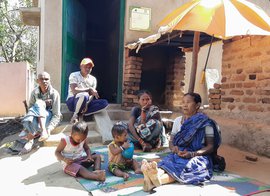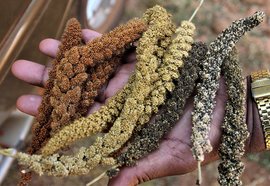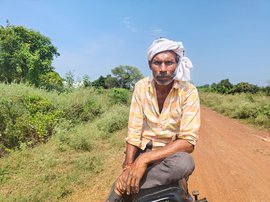Budhuram Chinda was trembling with fear. Standing just a few yards away were big black shapes, silhouetted in the moonlight. The 60-year-old Bhunjia Adivasi farmer stood peeping from a gap in the half-closed door of his house in Kathafar village.
The sight of large mammals was not unusual for the farmer who lives in one of the 52 human settlements in the core and buffer areas of the Sunabeda Wildlife Sanctuary in Odisha.
But even so, he said, “I trembled thinking that they would trample me and my kuccha house in minutes.” After a while he went into the backyard and stood near the tulsi plant: “I prayed to Goddess Laxmi and to those big mammals. The herd might have seen me.”
Budhuram’s wife, Sulaxmi Chinda, 55, also heard the trumpeting elephants. She was at their home in the village around a kilometre away, staying with their sons and their families.
The pachyderms exited the area after about an hour.
Looking back at the incident of December 2020, the farmer felt his prayers helped.
So, when the elephants changed their route in December 2022, not just Budhuram, but many residents of the 30 Adivasi villages of Nuapada district were relieved.


The house in Kathafar near Odisha' Sunabeda Wildlife Sanctuary where Budhuram and Sulaxmi live with their family
Sulaxmi and Budhuram have five sons and a daughter. The entire family is engaged in agriculture, cultivating about 10 acres of land. Their two eldest sons are married and live with their wives and children in Kathafar village; Budhuram and Sulaxmi shifted to the house near the fields a decade ago.
That’s where the elephants were milling around, looking for food.
The next morning when Budhuram went to inspect the damage to his paddy fields, he found that half an acre of standing crop had been destroyed. This was the khamunda (area carved out of a seasonal stream by building an embankment). This field is one of his main plots yielding about 20 bags (roughly a tonne) of paddy every year. “I lost five months’ worth of paddy,” he said and added, “to whom could I complain?”
Therein lies the twist: the land that Budhuram calls his own and cultivates along with Sulaxmi is not in his name. He and many other farmers who cultivate land within the buffer and core area of the 600 square kilometre sanctuary do not have land records in their name and do not pay rent either. “Most of the land I cultivate belongs to the wildlife department. I have not been allotted forest rights act [ The Scheduled Tribes and Other Traditional Forest Dwellers (Recognition of Forest) Rights Act ] patta [official land deed],” he pointed out.
Budhuram and Sulaxmi belong to the Bhunjia community of which there are 30 families in his village Kathafar (Census 2011). Other Adivasi communities living here are Gond and Paharia. Their village in Boden block of Nuapada district in Odisha, lies on the southern edge of the Sunabeda plateau, close to neighbouring Chhattisgarh.
This is the route that elephants take as they cross over.


Left: Budhuram and his wife Sulaxmi (right) in their home next to his fields
In the 2008-2009 annual report of the Ministry of Environment and Forests, Sunabeda was identified as one of four new tiger reserves. Apart from the tiger, it has leopards, elephants, sloth bear, Indian wolf, boars, gaur and wild dogs.
Officials of the wildlife department had visited and conducted several informal meetings in different villages of Sunabeda and Patdarha plateau areas including Kathafar, trying to convince villagers who live in the core areas to relocate. In 2022, people of two villages – Dhekunpani and Gatibeda – agreed to the relocation.
Those who wouldn’t just have to put up with the marauding mammals.
Odisha recorded 1976 elephants at large, says the Wildlife Census for 2016-17. Its forest cover of around 34 per cent is no doubt a juicy attraction. Of notice is the bamboo in the Sunabeda sanctuary, points out Mayadhar Saraf: “They pass through in the Sunabeda-Patdarha plateau where bamboo is abundant.” A former Wildlife Warden he adds, “they enter Nuapada and cover about 150 km inside the district before they exit into Chhattisgarh to the west.”
Once fed, the elephants then return to Balangir after about a month, taking more or less the same route.
This bi-annual journey sets them directly on a path where other Bhunjia, Gond and Paharia Adivasi farmers like Budhuram practise rain-fed cultivation on small parcels of land both inside and adjacent to the Sunabeda sanctuary. In a report on ownership of land among Adivasi in Odisha"Among Adivasi households surveyed in Odisha, 14.5 per cent were recorded as landless and 69.7 per cent as marginal," says the Status of Adivasi Livelihoods Report 2021 .


Budhuram and Sulaxmi cultivate vegetables on the land in front of their house (left) and banana in their backyard (right)
Siba Prasad Khamari, deputy ranger of the Komna range says that the pachyderms visit this area twice a year – once at the first monsoon rain [July] and again in December. He patrols this sanctuary and has first-hand knowledge of their presence. He says that on their way, the animals forage for different species of grass as well as agricultural crops, mainly kharif paddy. “Elephants destroy crops and houses every year in different villages,” he said, referring to the events of December 2020.
So Budhuram’s experience of losing standing crops to a herd is not unusual.
When farmers lose crops to any wild animals, they are entitled to Rs. 12,000 per acre for cash crops and Rs. 10,000 for paddy and cereals, says the official website of the PCCF (Wildlife) and Chief Wildlife Warden of Odisha. It quotes the Wildlife (Protection) (Odisha) Rules 1974.
But with no land ownership record, Budhuram cannot claim this compensation.
“I inherited [the land] from my ancestors, but according to the law Forest Conservation Act, 1980 , everything belongs to the sarkar [government],” Budhuram pointed out. “The wildlife department imposes restrictions on our movements as well as efforts to develop our land and agriculture,” he added.
He is referring to the collection of kendu leaves – a steady source of income for people living in the forest. “The right of ownership, access to collect, use, and dispose of minor forest produce,” is allowed under the Forest Rights Act (FRA), 2006. However, the forest dweller says that this right has been denied.
Forest produce such as mahua flowers and fruits, char , harida and aanla fetch a good price at the market in Boden which is around 22 km from their village. The lack of transport facilities means Budhuram cannot always go to the market himself. Traders pay an advance to the villagers for the products, but it is lower than the price at which Budhuram could have sold it had he gone himself. “But there is no alternative,” he says.
*****


Left: Chilli plants covered with a mosquito net to protect them from marauding chickens. Right: Budhuram and his family own 50 cattle and a few goats
In the aat (upland) in front of their farmhouse, Budhuram and Sulaxmi cultivate maize, brinjal, chilli, short-duration paddy and pulses such as kuloth (horse gram) and arhar . In the mid and lowlands (locally known as bahal ), they cultivate paddy, both - medium and long duration- varieties.
In the kharif season, Sulaxmi works in their fields near the Patdarha forest area – weeding, looking after the plants, collecting green leaves and tubers. “I have been relieved from the task of cooking since my eldest son got married three years ago. Now my daughter-in-law is responsible,” she said.
The family owns around 50 cattle including three pairs of bullocks and a pair of buffalos. The bullocks help in ploughing the land – the family own no mechanical farming equipment.
Budhuram milks the cows and takes the goat and sheep grazing. They are also rearing some goats for their own consumption. Although the family lost nine goats to wild animals in the last two years, they do not want to give up goat-rearing.
In the last kharif season, Budhuram cultivated paddy in five acres of land. The other crops he had tried were two varieties of beans, mung (green gram), biri (black gram), kuloth (horse gram), groundnut, chilli, maize, and banana. “I didn't get a single seed last year from mung as the crop failed due to severe cold, but that was compensated by other pulses,” he said.
“We get about two tonnes of paddy and sufficient pulses, millets, vegetables and oilseeds for self-consumption,” said Sulaxmi. The couple say they do not use any chemical fertilisers or pesticides either; cattle dung and urine and crop residues are enough. “If we say we have problems or there is a shortage of food, it would be like blaming the earth,” said Budhuram. “How will Mother Earth provide food if you do not become a part of it?” Sulaxmi added.
During the busy season when there is transplantation, weeding and harvesting, the entire family pitches in, and they also work on others’ land; any payment is often made in paddy.

The paddy fields that were destroyed by elephants in 2020. The following year, in 2021, the rice grew without any cultivation. 'I saw that seeds had fallen to the ground due to the elephants’ trampling. I was sure that they would germinate,' said Budhuram
The year the elephants destroyed the standing crop, Budhuram says that he didn’t cultivate that land the following year – 2021. His decision had a happy ending: “I saw that seeds had fallen to the ground due to the elephants’ trampling. I was sure that they would germinate,” he said. “The seeds sprouted at the first fall of rain in monsoon, and I watched over them. I got 20 bags [one tonne] of paddy without any [monetary] investment.”
The sarkar , feels this Adivasi farmer, “will not understand how our lives are inseparable from nature. This soil, the water and the trees, the animals, birds and insects – they help each other to exist.”
*****
The movement of the elephants also causes another problem in this area. Where there are open wires, the elephants often bring them down, and the villages in the Komna and Boden blocks of the district must go without electricity till they are repaired.
In 2021, a herd of 30 elephants had gone to neighbouring Chhattisgarh via the Sitanadi sanctuary from the Gandhamardan forest range in Odisha. Their route heading north-east, as mapped by the forest department, was through Bolangir district towards Kholi village in Nuapada district. Two of them returned in December 2022 on the same route.
Instead of swinging by the 30 villages belonging to the Sunabeda panchayat on their annual journey, they directly entered the Sunabeda Wildlife Sanctuary and left the same way.
Everyone breathed a sigh of relief.



